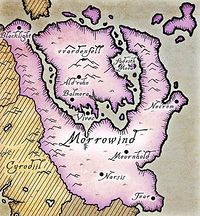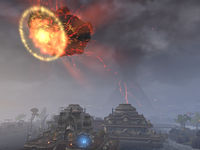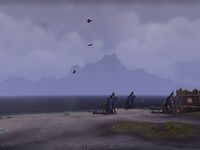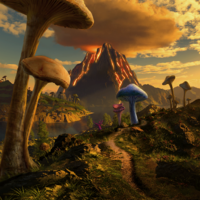Lore:Red Mountain
| This page is currently being redesigned for the Lore Places Project (LPP). The page may need work to meet the standards outlined on the project page. |
| To meet our site's higher standard of quality, this article or section may require cleanup. The user who placed this here had the following concern: Needs history, Battle of Red Mountain, post Dagoth Ur To leave a message about the cleanup for this article, please add it to this article's talk page. |
| Red Mountain | |
|---|---|
| Type | Mountain |
| Continent | Tamriel |
| Province | Morrowind |
| Appears in | Arena, Morrowind, ESO, Legends |
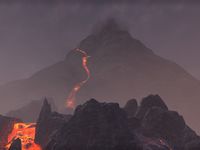
Red Mountain (Dragon: Sahqo-Strunmah, "Red-Mountain";[1] Dwemer: Vvardenfell, "City of the Strong Shield")[2], also known as Mount Vvardenfell[3] and Dagoth-Ur,[4][5][6][7][8][9][10][11][12] is a massive volcano that dominates the island of Vvardenfell in Morrowind. Prior to its most recent catastrophic eruption, it was the highest mountain in all of Tamriel.[13] On a clear day, Red Mountain's peak could be seen from the city of Mournhold, some 250 miles to the south.[2] The mountain is generally considered the most dangerous region in Vvardenfell, and has erupted at least thrice in history: the Sun's Death event of 1E 668, the Days of Fire in 2E 882,[14] and the Red Year of 4E 5[15] (although it was very close to erupting during Clavicus Vile's plot to drain Vivec's power in 2E 582).[16] The Red Year eruption in particular was so devastating that Red Mountain's height was permanently reduced, and the Throat of the World claimed the title of Tamriel's highest peak from then on.[13][17]
The Dwemer settled in the vicinity of Red Mountain as early as the Merethic Era, giving it the name Vvardenfell. In the First Era, the Battle of Red Mountain occurred on its slopes, resulting in the outright disappearance of all Dwemer and the rise of the Tribunal. This event likely coincided with the volcano's first major eruption, which blanketed the skies of Tamriel with ash for an entire year. Near the end of the Second Era, Voryn Dagoth (believed to have died at the Battle of Red Mountain) awoke within its bowels and challenged the power of the Tribunal, taking on the name "Dagoth Ur", which soon became applied to the whole mountain due to Dagoth's presence. Access to Red Mountain became restricted in the late Third Era, when the Tribunal built the Ghostfence around the perimeter of the mountain to contain the Ash Blight originating from within. The only way inside without the use of magic was through Ghostgate in the south. Due to the proliferation of disease-carrying ash storms, few dared to venture past the Ghostfence. It was known, however, that four ancient Dwemer Citadels were hidden in the region, three of which were residences for Dagoth Ur's most trusted ash vampires; the fourth was the lair of Dagoth Ur himself. Even though this area was extremely dangerous, malachite and ebony mines were set up inside the Ghostfence, under Imperial guard or by enterprising Ashlanders.[18] Ultimately, Dagoth Ur was defeated in his subterranean lair in 3E 427 by the Nerevarine, dispelling the supernatural ash storms. However, the disappearance of Vivec led to the destabilization of the suspended meteor Baar Dau, which impacted Nirn in 4E 5, triggering the most powerful eruption of Red Mountain to date. Known as the Red Year, the eruption caused widespread death and destruction along with a mass exodus of Morrowind's inhabitants.
The geography of Red Mountain is ever-changing. In the wake of an eruption, lava channels form deep ravines called foyada, which, once cooled, are used as roads by the Ashlanders. Bubbling lava pools dot the landscape, fed by magma from deep within the earth. The harsh climate of Red Mountain's slopes makes it accommodating to strange creatures that thrive in volcanic environments, including ash hoppers, fetcherflies, and shalks, as well as hardy vegetation such as scathecraw. Skylamps are known to fly alongside it.[19] As the volcano is still active as of the Fourth Era, it is unlikely that any populated settlements still exist in the region.
History[edit]
|
When Trinimac and Auriel tried to destroy the Heart of Lorkhan it laughed at them. It said, "This Heart is the heart of the world, for one was made to satisfy the other." So Auriel fastened the thing to an arrow and let it fly long into the sea, where no aspect of the new world may ever find it.
—The Monomyth |
|
Beneath Red Mountain, Dwemer miners discovered a great magical stone. By diverse methods, Lord Kagrenac, High Priest and Magecrafter of the ancient Dwemer, determined that this magical stone was the heart of the god Lorkhan, cast here in the Dawn Era as a punishment for his mischief in creating the mortal world.
—Kagrenac's Tools |
Red Mountain is said to have been formed at the time of the Convention, when Lorkhan's heart was removed and thrown into the sea; Red Mountain formed where the Heart of Lorkhan landed.[20][21] Long after, the Dwemer established themselves in Morrowind, and Red Mountain became a fortress at the heart of the Dwemer kingdom of Vvardenfell. The Dwemer eventually united with the Chimer to expel the Nords from Morrowind in 1E 416.[2][22] The two elven races coexisted peacefully under the banner of the kingdom of Resdayn for a time, until the Chimer general Indoril Nerevar learned that the Dwemer had found the Heart of Lorkhan and sought to use it to empower the Numidium. This led to the War of the First Council, which culminated in the Battle of Red Mountain.[23] Coinciding with the war, Red Mountain erupted in 1E 668, reshaping the island of Vvardenfell and blotting out the sun for a full year. This event became known as the Sun's Death.[15][2]
Battle of Red Mountain[edit]
The Battle of Red Mountain was the climactic battle of the War of the First Council, and resulted in the sudden disappearance of the entire Dwemer race from Nirn.[24][22] The battle was fought at Red Mountain in Resdayn (present-day Morrowind) around 1E 700[25] (or possibly earlier),[nb 1] between the Chimer (led by General Nerevar, the Hortator) and the Dwemer (led by Dumac Dwarfking),[22][26] along with armies of Nords and Orcs.[23][27] The exact truth of what happened cannot be determined due to conflicting accounts,[28] but all agree that by the time the dust settled, much of that dust was all that remained of the Dwemer.[22] Though Nerevar died, his people claimed victory, and four Chimer were positioned to become living gods.[24][22]
The First Council was held together for hundreds of years thanks to the friendship between Dumac and Nerevar. However, through means lost to history, Lord Voryn Dagoth of House Dagoth learned of a Dwemer scheme: deep in the bowels of Red Mountain on the island of Vvardenfell, the Dwemer had found the Heart of Lorkhan, and High Craftlord Kagrenac planned to harness it and use it to power a giant mechanical god.[24][22][29] Lord Dagoth reported this to the Chimer leadership, and eventually, the Hortator Nerevar confirmed it with his patron Azura. Nerevar confronted his friend Dumac, and they quarreled bitterly (some sources assert Dumac did not know of Kagrenac's plan at the time and thus misunderstood Nerevar's concerns). As a result, Nerevar led the Chimer to war in order to stop this "profane" usurpation.[24][22]
At the start of the war, Dwemeri forces were concentrated in the northwest of the province, and their campaign initially had great success throughout the north.[23][30] There is speculation that many of the great metal automatons the Dwemer used as troops in the battle were built in the Great Workshops of Nchardak on the island of Solstheim. The coastal Dwemeri city was reputedly able to produce one automaton a day, an apparently impressive rate of production.[31] Many outlanders were at the battle, notably Orcs and Nords, and sources often designate them as allies of the Dwemer.[23]
Nerevar, meanwhile, led his united people, the nomadic Ashlanders as well as the Great Houses (House Redoran, in particular, likes to trumpet its substantial contribution of warriors to the battle).[23][32][33] Nerevar did not have full control of the Chimer forces until a series of defeats convinced the Great Houses to relinquish command.[30] Once he had full command of the Chimer forces, Nerevar carefully orchestrated a confrontation at Dumac's citadel, a great Dwemer stronghold within Red Mountain where the Heart was being kept.[23][2]
The bulk of Nerevar's troops left Narsis and headed north at roughly the same time as a horde of westerners entered Morrowind from the west and began crossing the Inner Sea.[24][27] Some sources claim that all who opposed Nerevar's forces in the battle were exterminated.[23][30] Others state that while all enemies of the Chimer forces were decisively defeated, only the Dwemer were wiped out completely.[34]
- → For more accounts of the battle see: Battle of Red Mountain
Second Era[edit]
Long restive, Red Mountain awoke again briefly in 2E 582, an apparent consequence of Vivec's power being siphoned away. The culprit behind the Warrior-Poet's debilitating affliction was the Daedric Prince Clavicus Vile, who needed Tribunal power to find and enter Sotha Sil's Clockwork City. This resulted in Vivec being severely weakened, to the point that Baar Dau threatened to fall and Red Mountain erupted, endangering Vvardenfell. Fortunately, Vivec's powers were restored through the actions of an Outlander and disaster was averted.[16]
In the 2E 882, known as the Days of Fire[14] to the Dunmer, Dagoth Ur awoke beneath Red Mountain causing it to erupt and unleash The Blight and Corprus across Morrowind. That same year the Tribunal journeyed to Red Mountain to renew their connection to the Heart in a bathing ritual, they encountered Dagoth Ur, reborn to a new incarnation, and with divine power that could more than match their own.[35][36][37] Unable to enter Red Mountain's Heart Chamber, they were forced to retreat. Dagoth Ur had sole control of the Heart from this point on and grew stronger while the Tribunal grew weaker.[37]
Following the Days of Fire the Tribunal and their followers would launch seasonal campaigns to Red Mountain in an effort to reclaim the Heart and slay Dagoth Ur and his kin, but they would be repeatedly beaten back and the Heart would always revive them.[35] When this strategy proved ineffective the Tribunal erected the Ghostfence around Red Mountain to contain the spread of the Blight and the Corprus monsters.[38]
Third Era[edit]
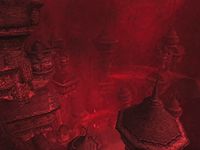
During the Imperial Simulacrum, Jagar Tharn used the Dwarven mines beneath the mountain as a hiding place for a piece of the shattered Staff of Chaos. The Eternal Champion discovered the entrance to the mines by striking the Hammer of Gharen against the Anvil of Mithas to produce a ringing which would reveal its location. The hero retrieved the piece, completing the Staff, only to discover that Tharn had drained its power into the Jewel of Fire.[39] After their victory over Tharn, many Imperial-loyalists had retraced their steps throughout the adventure, among these places would include the Dagoth-Ur mines.[40]
In 3E 417 two members of the Tribunal, Almalexia and Sotha Sil alongside the Buoyant Armigers would journey to Red Mountain in this attempt to retake the Heart of Lorkhan from Dagoth's forces but ended up losing Sunder and Keening, two of Kagrenac's Tools in an ambush which forced them to retreat and end the campaigns to Red Mountain.[37] From this point onwards almost all of the territory inside of the Ghostfence would be under the control of the Sixth House.
The Nerevarine would arrive in Morrowind in 3E 427.[36][41] The Nerevarine would travel to Red Mountain to confront Dagoth Ur and using the Tools of Kagrenac they would break the enchantments on the Heart of Lorkhan, severing Dagoth Ur's connection with it and ultimately vanquishing him.[42]
After Dagoth Ur's defeat, the Ghostfence was deactivated and the blight storms came to an end.[42]
Fourth Era[edit]

In 4E 5, recorded by the Dunmer as the Red Year, Red Mountain erupted shortly after Baar Dau, since converted into the Ministry of Truth, completed its descent and impacted into Vivec City.[43] The eruption produced massive amounts of smoke and toxic ash that smothered much of Morrowind and left Vvardenfell almost entirely uninhabitable.[44] The portions of Morrowind that survived the initial calamity were not spared for long, as ash from the continually-erupting mountain poisoned the land and sea over the following decades.[44][45]. As of 4E 201, the volcano was still experiencing ongoing eruptions with ash reaching as far as Solstheim.[46]
Gallery[edit]
-
Red Mountain seen from Stonefalls, 2E 582
Notes[edit]
- While not accessible, Red Mountain is clearly visible from Solstheim in the Dragonborn expansion for TES V: Skyrim, from Stonefalls in Elder Scrolls Online, and throughout Vvardenfell in Elder Scrolls Online: Morrowind.
- There was a Nordic clan known as Clan Red-Mountain. The figure known as Odrav Anvil-Hand brought great honor to the family. Whether they are related to Red Mountain itself is unclear.[47]
- Red Mountain is alluded to as the Red Tower in the Prophecy of the Dragonborn.
See Also[edit]
- For game-specific information, see the Arena, Morrowind, Elder Scrolls Online
 , and Legends
, and Legends articles.
articles.
References[edit]
- ^ Word Wall in Skyrim
- ^ a b c d e Pocket Guide to the Empire, 1st Edition: Morrowind — Imperial Geographical Society, 2E 864
- ^ The Great War — Legate Justianus Quintius
- ^ Ria Silmane's dialogue in Arena
- ^ The Pig Children — Tyston Bane
- ^ Codex
- ^ The Black Arrow, v 1 — Gorgic Guine
- ^ 2920, Sun's Dusk — Carlovac Townway
- ^ Ancestors and the Dunmer
- ^ The Real Barenziah, v 5 — Anonymous
- ^ Hasphat's notes for Cosades — Hasphat Antabolis
- ^ Generic Dialogue R in Morrowind
- ^ a b Pocket Guide to the Empire, 1st Edition: Skyrim — Imperial Geographical Society, 2E 864
- ^ a b The Pilgrim's Path — Tribunal Temple
- ^ a b The Nirnroot Missive — Sinderion
- ^ a b Events of ESO: Morrowind
- ^ Loading screen in Skyrim
- ^ Red Mountain region in Morrowind
- ^ The Art of Morrowind
- ^ The Monomyth
- ^ The Heart of Lorkhan, My Final Prize — Artisan Lenarmen
- ^ a b c d e f g Nerevar at Red Mountain — the Tribunal Temple
- ^ a b c d e f g The War of the First Council — Agrippa Fundilius
- ^ a b c d e The Battle of Red Mountain — Vivec
- ^ Dwemer Inquiries Vol I — Thelwe Ghelein, Scholar
- ^ Pocket Guide to the Empire, 3rd Edition: All the Eras of Man, A Comprehensive History of our History — Imperial Geographical Society, 3E 432
- ^ a b Five Songs of King Wulfharth
- ^ Progress of Truth — Dissident Priests
- ^ Kagrenac's Tools — Gilvas Barelo
- ^ a b c The Real Nerevar
- ^ Neloth's dialogue in Skyrim: Dragonborn
- ^ The True Noble's Code — Serjo Athyn Sarethi
- ^ Nerevar Moon-and-Star
- ^ Saint Nerevar
- ^ a b Plan to Defeat Dagoth Ur — Vivec
- ^ a b Pocket Guide to the Empire, 3rd Edition: The Temple: Morrowind — Imperial Geographical Society, 3E 432
- ^ a b c Dagoth Ur's Plans — Tribunal Temple
- ^ Vivec's dialogue in Morrowind
- ^ Events of Arena
- ^ A Minor Maze
- ^ Events of Morrowind
- ^ a b Events of The Citadels of the Sixth House in Morrowind
- ^ The Red Year — Melis Ravel
- ^ a b The Reclamations — Thara of Rihad
- ^ Gjalund Salt-Sage's dialogue in Skyrim: Dragonborn
- ^ Garyn Ienth's dialogue in Skyrim: Dragonborn
- ^ Disarm second word wall translation in Skyrim
